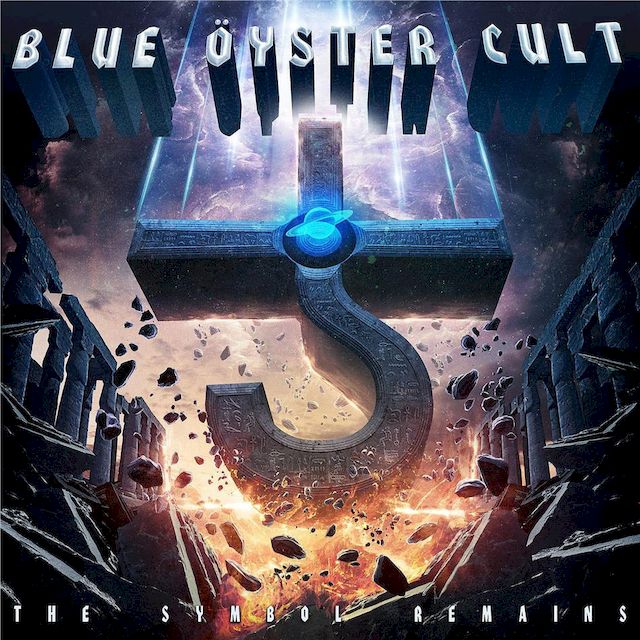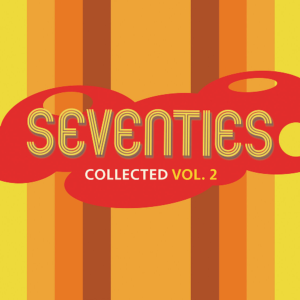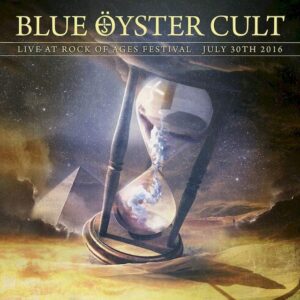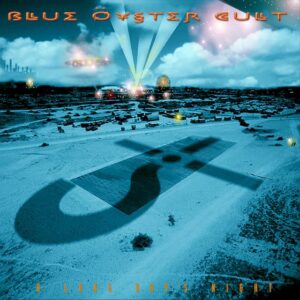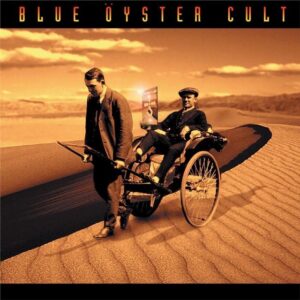Blue Öyster Cult ¦ The Symbol Remains
CHF 27.00 inkl. MwSt
CD (Album)
Nicht vorrätig
Release
Veröffentlichung The Symbol Remains:
2020
Hörbeispiel(e) The Symbol Remains:
The Symbol Remains auf Wikipedia (oder andere Quellen):
The Symbol Remains is the fourteenth[note 1] studio album by American rock band Blue Öyster Cult, released on October 9, 2020.[3]
The title comes from a lyric in the song "Shadow of California" on Blue Öyster Cult's 1983 LP The Revölution by Night.[4]
This is the band's first studio release since 2001's Curse of the Hidden Mirror, making it the longest gap between the band's studio albums. It also marks the recording debut by long-time members Jules Radino and Richie Castellano, as well as the first studio album since 1985's Club Ninja to not feature Allen Lanier, who died in 2013. The album entered the Billboard 200 album chart at No. 192, making it their first album to chart in the United States since Imaginos in August 1988.
Background
The lack of sales of the band's previous studio album, Curse of the Hidden Mirror (2001), contributed to the band's disinterest in recording new music. Frontman Eric Bloom noted in 2017 that "it costs money to make a record", and that the time spent producing an album would be better spent touring "than making a record that nobody's going to buy". He did not completely rule out the possibility of the band going back to the studio.[5]
Lead guitarist Buck Dharma stated in another interview that the band had "tentative" plans to record in 2017, and noted that the then-current band was "so good it would be a shame not to."[6] Dharma also revealed that he had originally intended to contact longtime band manager and collaborator Sandy Pearlman about ideas for the album, but Pearlman's death in 2016 from a stroke prevented that from happening.[7]
In April 2019, Bloom said that a new album would eventually arrive, and announced that the band would "soon" be signing a new recording contract.[8] In July 2019, it was announced that the band had signed with Frontiers Records and that the album would be released in 2020. Bloom noted that half of the songs were already written, with the remaining portion to be written during production of the album.[9]
The album art and track listing were revealed in August 2020.[3]
Songs
Several singles and music videos were released to promote the album. On August 28, 2020, "That Was Me" and "Box in My Head" were released for streaming on YouTube. Several days later, a music video featuring former member Albert Bouchard was released for the former. A video was released for "Box in My Head" on September 10. Additionally, the band released a video for "Tainted Blood" on September 25.[10] On the day of the album's release, the band released a video for "The Alchemist".[11]
According to Buck Dharma, "Box in My Head" is about "trying to intrigue a lady" and that the mind is an "enigmatic and curious place". It features lyrics by novelist John Shirley, a frequent collaborator of the band.[12] "The Alchemist" references the H.P. Lovecraft short story The Alchemist,[13] while "Florida Man" references the internet meme of the same name.[14] The Castellano-penned "The Return of St. Cecilia" references a song from the album that the band recorded for Elektra Records in 1970 under the name "Stalk-Forrest Group". Another Castellano contribution, "The Machine", is about cell phones.[15]
A different recording of the song "Fight" had been released by Buck Dharma in 2015, as a solo track. Additionally, demo recordings of two other songs, "Nightmare Epiphany" and "Secret Road" were released in 2000 in an archive compilation released by Dharma.[16]
"Edge of the World" is a song about conspiracy theories and references alien abductions.[citation needed]
Reception
| Aggregate scores | |
|---|---|
| Source | Rating |
| Metacritic | 77/100[17] |
| Review scores | |
| Source | Rating |
| AllMusic | |
| Louder Sound | |
| Uncut | 60/100[17] |
| The Wire | 80/100[17] |
The Symbol Remains has received a positive reception from critics, and "The Alchemist" was particularly praised. The album holds a 77/100 aggregate rating on Metacritic as of January 2021.
Dom Lawson of Blabbermouth.net gave the album a positive review, citing songs like "Box in My Head" and "The Alchemist" as high points on the album.[20] Scott McLennan of The Arts Fuse hailed "The Alchemist" as "a sprawling tale of a cursed monarchy, palace treachery, and sorcery", noting that Bloom's performance was at "peak harrowing form". McLennan also praised Dharma's "speedy country-rock riff" playing on "Train True (Lennie's Song)".[15] Thom Jurek of AllMusic hailed the album as a "thoroughly inspired" return for the band, and compared the sound of many of the album's songs to Blue Öyster Cult's back catalogue, as well as groups like Head East and Iron Maiden.[21] Writing for BraveWords, Paul Stenning cited the material as "memorable" and marked out "Nightmare Epiphany", "Edge of the World" and "Stand and Fight" as standout tracks.[22]
A review in Uncut cited "The Machine", "Stand and Fight" and "The Alchemist" as the album's best moments.[17]
Track listing
| No. | Title | Writer(s) | Lead vocals | Length |
|---|---|---|---|---|
| 1. | "That Was Me" | Eric Bloom, Richie Castellano, John Shirley | Bloom | 3:18 |
| 2. | "Box in My Head" | Donald Roeser, Shirley | Roeser | 3:46 |
| 3. | "Tainted Blood" | Bloom, Castellano | Castellano | 4:17 |
| 4. | "Nightmare Epiphany" | Shirley, D. Roeser | Roeser | 5:30 |
| 5. | "Edge of the World" | Castellano | Bloom | 4:52 |
| 6. | "The Machine" | Castellano | Castellano | 4:14 |
| 7. | "Train True (Lennie's Song)" | D. Roeser, Zeke Roeser | Roeser | 3:57 |
| 8. | "The Return of St. Cecilia" | Castellano, Richard Meltzer | Castellano | 4:12 |
| 9. | "Stand and Fight" | Bloom, Castellano | Bloom | 4:48 |
| 10. | "Florida Man" | D. Roeser, Shirley | Roeser | 4:08 |
| 11. | "The Alchemist" | Castellano | Bloom | 6:00 |
| 12. | "Secret Road" | Shirley, D. Roeser | Roeser | 5:24 |
| 13. | "There's a Crime" | Jeff Denny, Jules Radino | Bloom | 3:37 |
| 14. | "Fight" | D. Roeser, Ira Rosoff, James Wold | Roeser | 3:12 |
| Total length: | 61:06 | |||
| No. | Title | Length |
|---|---|---|
| 15. | "That Was Me" (acoustic remix) |
Personnel
Band
- Eric Bloom – guitars, keyboards, vocals
- Buck Dharma – guitars, keyboards, programming, vocals
- Richie Castellano – guitars, keyboards, programming, vocals
- Danny Miranda – bass guitar, backing vocals
- Jules Radino – drums, percussion, backing vocals
Additional musicians
- Albert Bouchard – backing vocals, cowbell and percussion on "That Was Me"
- Andy Ascolese – keyboards on "Nightmare Epiphany" and "Florida Man"; piano on "The Alchemist"
- David Lucas – backing vocals on "Edge of the World", "The Machine", "Florida Man" and "Secret Road"; cowbell on "Fight"
- Phil Castellano – harmonica on "Train True (Lennie's Song)"; gang vocals on "Stand and Fight"; backing vocals and claps on "Florida Man"; choir programming on "Secret Road"
- Kasim Sulton – backing vocals on "The Return of St. Cecilia" and "There's a Crime"
- Steve La Cerra – gang vocals on "Stand and Fight"; backing vocals and claps on "Florida Man"
- Kevin Young – gang vocals on "Stand and Fight"; backing vocals and claps on "Florida Man"
- John Castellano – backing vocal on "Florida Man"
- Jeff Nolan – theremin on "Fight"
Production
- Produced by Eric Bloom, Buck Dharma and Richie Castellano
- Executive produced by Steve Schenck
- Chief Engineer – Richie Castellano
- Overdub engineering – Buck Dharma
- Engineer – Sam Stauff
- Assistant engineer – Steve La Cerra
- Mixed by Tom Lord-Alge
- Mastered by Ted Jensen
Charts
| Chart (2020) | Peak position |
|---|---|
| Belgian Albums (Ultratop Flanders)[24] | 186 |
| Belgian Albums (Ultratop Wallonia)[25] | 27 |
| Finnish Albums (Suomen virallinen lista)[26] | 17 |
| French Albums (SNEP)[27] | 64 |
| German Albums (Offizielle Top 100)[28] | 39 |
| Japanese Albums (Oricon)[29] | 161 |
| Scottish Albums (OCC)[30] | 31 |
| Swedish Albums (Sverigetopplistan)[31] | 31 |
| UK Independent Albums (OCC)[32] | 8 |
| UK Rock & Metal Albums (OCC)[33] | 5 |
| US Billboard 200[34] | 192 |
| US Independent Albums (Billboard)[35] | 36 |
| US Top Album Sales (Billboard)[36] | 12 |
| US Top Hard Rock Albums (Billboard)[37] | 10 |
| US Top Rock Albums (Billboard)[38] | 32 |
| US Top Tastemaker Albums (Billboard)[39] | 13 |
Notes
- ^ This could be counted as either the group's fourteenth or fifteenth studio effort, depending on whether 1994's Cult Classic, an album consisting of re-recordings of some of the band's earlier music, is considered a proper studio album or not.
References
- ^ "The Symbol Remains - Blue Oyster Cult | Songs, Reviews, Credits | AllMusic". AllMusic.
- ^ a b c d The Symbol Remains liner notes. Frontiers Records. 2020. p. 14.
- ^ a b "BLUE ÖYSTER CULT Unveils Details Of First Album In Nearly Two Decades, 'The Symbol Remains'". Blabbermouth.net. August 15, 2020. Retrieved August 16, 2020.
- ^ Winterbottom, Roger. "Blue Öyster Cult - The Symbol Remains (Frontiers Music)". Yorkshire Times. Retrieved January 5, 2021.
- ^ Staff (July 14, 2017). "Blue Oyster [sic] Cult's Eric Bloom is a Road Warrior, but Says Albums Don't Pay". OC Weekly. Duncan McIntosh. Retrieved July 14, 2019.
- ^ Tatangelo, Wade (January 5, 2017). "Interview: Buck Dharma on writing Blue Oyster [sic] Cult's biggest hits". Heraldtribune.com. Retrieved July 14, 2019.
- ^ Hernandez, Raoul (August 9, 2017). "Buck Dharma in the 21st Century! Epic Q&A with Blue Öyster Cult's "Reaper"". The Austin Chronicle. Nick Barbaro. Retrieved July 14, 2019.
- ^ Lenker, George (April 8, 2019). "Blue Oyster [sic] Cult singer talks longevity, new music and that 'more cowbell' sketch before Northampton show". Masslive. Retrieved July 14, 2019.
- ^ Kielty, Martin (July 10, 2019). "Blue Öyster Cult Sign Deal for New Album". Ultimate Classic Rock. Retrieved July 14, 2019.
- ^ "Watch Music Video for New Blue Oyster Cult Song 'Tainted Blood'". Blabbermouth.net. September 25, 2020. Retrieved September 25, 2020.
- ^ "Watch Blue Öyster Cult's Music Video For 'The Alchemist'". Blabbermouith.net. October 9, 2020. Retrieved October 9, 2020.
- ^ "Blue Oyster Cult Talk First New Album in 20 Years 'The Symbol Remains' [Interview]". Youtube.com. Q104.3 FM. Retrieved September 4, 2020.
- ^ The Symbol Remains liner notes. Frontiers Records. 2020. p. 11.
- ^ Cohen, Howard (October 9, 2020). "A rock group pays homage to its most frightful character yet. His name is 'Florida Man'". Miami Herald. Retrieved October 9, 2020.
- ^ a b McLennan, Scott (October 12, 2020). "Rock Album Review: Blue Öyster Cult — Still Defying Norms". Artsfuse.org. Retrieved October 13, 2020.
- ^ "Buck Dharma - Archive Volume III". Discogs. Retrieved October 10, 2020.
- ^ a b c d "The Symbol Remains by Blue Öyster Cult". Metacritic. Retrieved November 25, 2020.
- ^ Jurek, Thom. "The Symbol Remains - Blue Öyster Cult | Album Review". AllMusic. RhythmOne. Retrieved April 6, 2024.
- ^ Grinder, Sleaze (October 9, 2020). "Blue Oyster Cult echo past glories on The Symbol Remains". LouderSound. Retrieved October 22, 2020.
- ^ Lawson, Dom (October 8, 2020). "Blue Öyster Cult: "The Symbol Remains"". Blabbermouth.net. Retrieved October 9, 2020.
- ^ Jurek, Thom. "Blue Öyster Cult - The Symbol Remains". Allmusic.com. Retrieved October 16, 2020.
- ^ "BLUE ÖYSTER CULT – the Symbol Remains".
- ^ "「That Was Me / ザ・シンボル・リメインズ」 | Ward Records". ワードレコーズ | Ward Records (in Japanese). Retrieved September 25, 2020.
- ^ "Ultratop.be – Blue Öyster Cult – The Symbol Remains" (in Dutch). Hung Medien. Retrieved March 25, 2024.
- ^ "Ultratop.be – Blue Öyster Cult – The Symbol Remains" (in French). Hung Medien. Retrieved March 25, 2024.
- ^ "Blue Öyster Cult: The Symbol Remains" (in Finnish). Musiikkituottajat – IFPI Finland. Retrieved March 25, 2024.
- ^ "Lescharts.com – Blue Öyster Cult – The Symbol Remains". Hung Medien. Retrieved March 25, 2024.
- ^ "Offiziellecharts.de – Blue Öyster Cult – The Symbol Remains" (in German). GfK Entertainment Charts. Retrieved March 25, 2024.
- ^ "ザ・シンボル・リメインズ". Oricon.co.jp. Retrieved March 25, 2024.
- ^ "Official Scottish Albums Chart Top 100". Official Charts Company. Retrieved March 25, 2024.
- ^ "Swedishcharts.com – Blue Öyster Cult – The Symbol Remains". Hung Medien. Retrieved March 25, 2024.
- ^ "Official Independent Albums Chart Top 50". Official Charts Company. Retrieved March 25, 2024.
- ^ "Official Rock & Metal Albums Chart Top 40". Official Charts Company. Retrieved March 25, 2024.
- ^ "Blue Oyster Cult Chart History (Billboard 200)". Billboard. Retrieved March 25, 2024.
- ^ "Blue Oyster Cult Chart History (Independent Albums)". Billboard. Retrieved March 25, 2024.
- ^ "Blue Oyster Cult Chart History (Top Album Sales)". Billboard. Retrieved March 25, 2024.
- ^ "Blue Oyster Cult Chart History (Top Hard Rock Albums)". Billboard. Retrieved March 25, 2024.
- ^ "Blue Oyster Cult Chart History (Top Rock Albums)". Billboard. Retrieved March 25, 2024.
- ^ "Blue Oyster Cult Chart History (Top Tastemaker Albums)". Billboard. Retrieved March 25, 2024.
| Studio albums | |
|---|---|
| Live albums | |
| Other albums | |
| Songs | |
| Videos | |
| Related | |
Artist(s)
Veröffentlichungen von Blue Öyster Cult die im OTRS erhältlich sind/waren:
iHeart Radio Theater N.Y.C. 2012 ¦ Curse Of The Hidden Mirror ¦ The Symbol Remains ¦ A Long Day’s Night ¦ Live At Rock Of Ages Festival: July 30th 2016
Blue Öyster Cult auf Wikipedia (oder andere Quellen):
Blue Öyster Cult (Abkürzung BÖC) ist eine US-amerikanische Hardrock-Band. Die bekanntesten Singles sind (Don’t Fear) The Reaper vom 1976er Album Agents of Fortune und Godzilla vom Nachfolger Spectres. BÖC lieferte als erste Band in Konzerten eine Lasershow. Die Band gilt als Erfinder des Heavy-Metal-Umlauts. Die Band hat bislang weltweit über 24 Millionen Platten verkauft, davon 7 Millionen in den USA.[1]
Geschichte
Blue Öyster Cult wurde zunächst in den 1960er-Jahren als Soft White Underbelly auf Long Island, New York, gegründet. 1968 wurde daraus die Stalk-Forrest Group und 1970 führte man den bis heute gültigen Namen Blue Öyster Cult (zunächst jedoch ohne Trema) ein.
Das Unterlegen der Hardrock-Klänge mit Texten von Schriftstellern wie Samuel „Sandy“ Pearlman, Richard Meltzer, Michael Moorcock und Patti Smith, die in den 1970er Jahren mit dem Keyboarder Allen Lanier liiert war, verschaffte den Musikern den Ruf, die Heavy-Metal-Band der Intellektuellen zu sein.
Während man heute den Stil der Band als Psychedelic- und Prog-artigen Hardrock charakterisieren würde, war sie in ihren Anfangsjahren eher von Formationen wie Velvet Underground, Doors und MC5 inspiriert. Die Vermarktungsidee des Managers Sandy Pearlman und der Plattenfirma war allerdings zunächst ein amerikanisches Black Sabbath.[2] Die Rezeption ihrer Alben ist heute zu einem Großteil auf die Independent-Szene beschränkt. Einflüsse von BÖC finden sich bei wegweisenden Bands wie Sonic Youth und Hüsker Dü, oder auch bei Minutemen und Firehose, von denen es auch BÖC-Coverversionen gibt.
Die ersten drei Alben (Blue Öyster Cult, Tyranny and Mutation sowie Secret Treaties) etablierten die Band als psychedelisch inspirierten Westcoast-Rockact. Sie enthielten Songs, die heute als Klassiker anzusehen sind, wie z. B. Cities on Flame with Rock and Roll, The Red & the Black, 7 Screaming Diz-Busters, ME 262, Harvester of Eyes und vor allem Astronomy. Herausstechend waren auch die Gitarrenspiel-Künste von Donald Buck Dharma Roeser und die durch zeitgenössische Literaten wie Sandy Pearlman und Richard Meltzer beeinflussten Texte.
In den darauffolgenden Jahren ließ es Blue Öyster Cult musikalisch etwas ruhiger angehen (Agents of Fortune, Spectres, Mirrors) und integrierte unter anderem Kurt-Weill-Einflüsse. Die musikalische wie auch die textliche Ausrichtung veränderte sich in Richtung Science-Fiction und komplexeren Hardrock. Passend dazu lieferte BÖC als erste Band in Konzerten eine Lasershow. Ihre internationale Bekanntheit befand sich nun auf ihrem Höhepunkt, vor allem aufgrund des Hits (Don’t Fear) The Reaper von Agents of Fortune, der heute noch im Classicrock-Radio oft zu hören ist.
Es folgte Cultösaurus erectus, das den musikalischen Übergang in ihre 1980er-Phase markiert. Die folgende Tour mit Black Sabbath, Black & Blue, wurde von ca. 1,5 Millionen Zuschauern gesehen.
Die nächsten Studioalben Fire of Unknown Origin (mit ihrem größten US-Hit Burnin’ for You), The Revölution by Night und Club Ninja sind von straighteren Hardrock-Songs mit prägnanten Keyboards geprägt.
Das Konzeptalbum Imaginos, 1988 veröffentlicht, sollte eigentlich ein Soloalbum des langjährigen Schlagzeugers Albert Bouchard werden. Die Plattenfirma wollte es jedoch lieber als BÖC-Album veröffentlichen, woraufhin die anderen Mitglieder der Urbesetzung sowie zahlreiche Gastmusiker an Bord geholt wurden, um mit dem langjährigen Manager und Urheber der „Imaginos-Saga“, Sandy Pearlman, die Produktion des größtenteils fertigen Albums ohne Albert Bouchard zu Ende zu führen. Von Fans und Kritikern wurde das Werk nach seiner Veröffentlichung sehr zwiespältig aufgenommen und gehört bis heute zu den polarisierendsten Alben der Band.
Nach einigen Jahren Funkstille meldete sich BÖC 1998 mit einer Metal-dominierten CD namens Heaven Forbid zurück, der 2001 Curse of the Hidden Mirror und 2002 die Live-Aufnahme A Long Day’s Night folgten. Die Band spielt auch heute noch regelmäßig Konzerte, die sich aber vor allem auf die US-Westküste beschränken. Die beiden Gründungsmitglieder Joe und Albert Bouchard gründeten 2007 zusammen mit dem Ex-Alice-Cooper-Bassisten Dennis Dunaway die Band Blue Coupe, die 2011 den Longplayer Tornado on the Tracks veröffentlichte.
2012 verließ der Bassist Rudy Sarzo die Band, der bereits seit 2007 für Blue Öyster Cult tätig war.[3]
Überwiegend wird die Black & White-Periode der ersten drei Alben als schaffenstechnischer Höhepunkt der Band angesehen. Das 1976er Album Agents of Fortune mit der Single (Don’t Fear) The Reaper ist das kommerziell erfolgreichste Album der Band.
Über den Bandnamen und das Logo:
Der Name Blue Öyster Cult stammt aus dem Gedicht Imaginos des Managers Sandy Pearlman (Dieses Gedicht wurde 1988 in dem Album Imaginos wieder aufgegriffen). In dem Gedicht war „Blue Oyster Cult“ eine Gruppe von Aliens, welche die Geschichte der Erde beeinflussen wollten. Das Haken-und-Kreuz-Logo erscheint auf allen Alben.
Sonstiges
Die Texte zu den Songs Black Blade vom 1980er Album Cultösaurus Erectus sowie Veteran of the Psychic Wars vom Nachfolgealbum Fire of Unknown Origin (1981) schrieb Fantasy-Autorenlegende Michael Moorcock. Bei Black Blade handelt es sich um eine Liedversion von Moorcocks Saga vom ewigen Helden (Eternal Champion, im Liedtext Cosmic Champion) in seiner Inkarnation als Elric von Melniboné.
Die beiden Stücke Heavy Metal – The Black and Silver und Vengeance – The Pact vom 1981er Album Fire of Unknown Origin waren für den Film Heavy Metal (nach dem gleichnamigen Comicmagazin) bestimmt. Vengeance – The Pact kam jedoch nicht zum Einsatz, da es die Geschichte der letzten Episode aus dem Film vorweggenommen hätte. Letztlich war es dann ein komplett anderer Song, Veteran of the Psychic Wars, vom selben Album, der es auf den Soundtrack und in den Film schaffte, während von Vengeance – The Pact lediglich ein Textzitat aufgenommen wurde.
Bei dem Album Cult Classic von 1994 handelt es sich nicht um eine Best-of-Zusammenstellung. Vielmehr enthält es komplette Neueinspielungen älterer Songs und wird somit von der Band selbst als offizielles Album geführt. Der Hintergrund, vor dem das Album entstand, ist die TV-Verfilmung des Romans The Stand – Das letzte Gefecht von Stephen King. Das Buch beginnt mit dem Zitat der dritten und letzten Strophe aus (Don’t Fear) The Reaper, weshalb vorgesehen war, den Song an den Anfang des Films zu stellen (kurioserweise werden letztlich nur die ersten beiden Strophen gespielt). Da die Plattenfirma aber die Nutzung der Originalaufnahme verweigerte, spielte die Band in ihrer damaligen Besetzung den Song neu ein, woraus sich letztlich ein ganzes Album entwickelte.
Der Song Don’t Turn Your Back wurde in einem der Slenderspiele benutzt.
Songtexte von Blue Öyster Cult spielen eine Schlüsselrolle in dem Roman Die Ernte des Bösen aus der Cormoran-Strike-Serie von Robert Galbraith.
Auf dem im Jahre 1998 veröffentlichten Metallica Album Garage Inc. ist eine Coverversion des Songs Astronomy enthalten.
Im September 2009 erschien eine Coverversion von Burnin’ for You seitens der Band Shiny Toy Guns, welche als Werbespot des im Jahr 2010 veröffentlichten Lincoln MKS verwendet wurde.[4]
Diskografie
Studioalben
| Jahr | Titel Musiklabel | Höchstplatzierung, Gesamtwochen, AuszeichnungChartplatzierungenChartplatzierungen[5] (Jahr, Titel, Musiklabel, Platzierungen, Wochen, Auszeichnungen, Anmerkungen) | Anmerkungen | |||
|---|---|---|---|---|---|---|
| 1972 | Blue Öyster Cult Columbia | — | — | — | US172 (8 Wo.)US |
Erstveröffentlichung: 16. Januar 1972 |
| 1973 | Tyranny and Mutation Columbia | — | — | — | US122 (13 Wo.)US |
Erstveröffentlichung: Februar 1973 |
| 1974 | Secret Treaties Columbia | — | — | — | US53 (14 Wo.)US |
Erstveröffentlichung: April 1974 |
| 1976 | Agents of Fortune Columbia | — | — | UK26 (10 Wo.)UK | US29 (35 Wo.)US |
Erstveröffentlichung: 21. Mai 1976 |
| 1977 | Spectres Columbia | — | — | UK60 (1 Wo.)UK | US43 (14 Wo.)US |
Erstveröffentlichung: November 1977 |
| 1979 | Mirrors Columbia | — | — | UK46 (5 Wo.)UK | US44 (17 Wo.)US |
Erstveröffentlichung: 19. Juni 1979 |
| 1980 | Cultösaurus Erectus Columbia | — | — | UK12 (7 Wo.)UK | US34 (16 Wo.)US |
Erstveröffentlichung: 14. Juni 1980 |
| 1981 | Fire of Unknown Origin Columbia | — | — | UK29 (7 Wo.)UK | US24 (31 Wo.)US |
Erstveröffentlichung: Juli 1981 |
| 1983 | The Revölution by Night Columbia | — | — | UK95 (1 Wo.)UK | US93 (16 Wo.)US |
Erstveröffentlichung: November 1983 |
| 1985 | Club Ninja Columbia | — | — | — | US63 (14 Wo.)US |
Erstveröffentlichung: 10. Dezember 1973 |
| 1988 | Imaginos Columbia / Sony | — | — | — | US122 (8 Wo.)US |
Erstveröffentlichung: Juli 1988 |
| 1994 | Cult Classic SPV | — | — | — | — |
Erstveröffentlichung: Juni 1994 |
| 1998 | Heaven Forbid CMC | — | — | — | — |
Erstveröffentlichung: 24. März 1998 |
| 2001 | The Curse of the Hidden Mirror CMC / Sanctuary | — | — | — | — |
Erstveröffentlichung: 5. Juni 2001 |
| 2020 | The Symbol Remains Frontiers | DE39 (2 Wo.)DE | — | — | US192 (1 Wo.)US |
Erstveröffentlichung: 9. Oktober 2020 |
grau schraffiert: keine Chartdaten aus diesem Jahr verfügbar
Literatur
- Irwin Stambler: The Encyclopedia Of Pop, Rock And Soul. 3., überarbeitete Auflage. St. Martin’s Press, New York 1989, ISBN 0-312-02573-4, S. 68–70.
Einzelnachweise
- ↑ Blue Oyster Cult, Harrah's South Shore Room - Tahoe South. Archiviert vom Original am 15. Juni 2018; abgerufen am 12. November 2017.
- ↑ Martin Popoff: Agents of Fortune: The Blue Öyster Cult Story, Bedford UK 2016
- ↑ www.rockhard.de: Rudy Sarzo steigt bei Blue Öyster Cult aus
- ↑ SHINY TOY TELEVISION COMMERCIALS (Memento vom 12. Dezember 2009 im Internet Archive)
- ↑ Chartquellen:
- Offiziellecharts.de (DE)
- Hitparade.ch (CH)
- Officialcharts.com (UK)
- Billboard.com (US)
Weblinks
| |||||||||
| |||||||||
| Studioalben |
| ||||||||
|---|---|---|---|---|---|---|---|---|---|
| Livealben |
| ||||||||
| Kompilationen |
| ||||||||
| Soundtracks | |||||||||
| Singles |
| ||||||||
Same artist(s), but different album(s)...
-

Various ¦ Seventies Collected: Vol. 2
CHF 60.00Original price was: CHF 60.00.CHF 39.00Current price is: CHF 39.00. inkl. MwSt In den Warenkorb -

Blue Öyster Cult ¦ Live At Rock Of Ages Festival: July 30th 2016
CHF 29.00 inkl. MwSt In den Warenkorb -

Blue Öyster Cult ¦ A Long Day’s Night
CHF 47.00 inkl. MwSt In den Warenkorb -

Blue Öyster Cult ¦ A Long Day’s Night
CHF 29.00 inkl. MwSt In den Warenkorb -

Blue Öyster Cult ¦ Curse Of The Hidden Mirror
CHF 46.00 inkl. MwSt In den Warenkorb -

Blue Öyster Cult ¦ Curse Of The Hidden Mirror
CHF 29.00 inkl. MwSt In den Warenkorb

